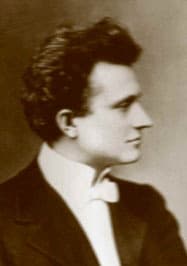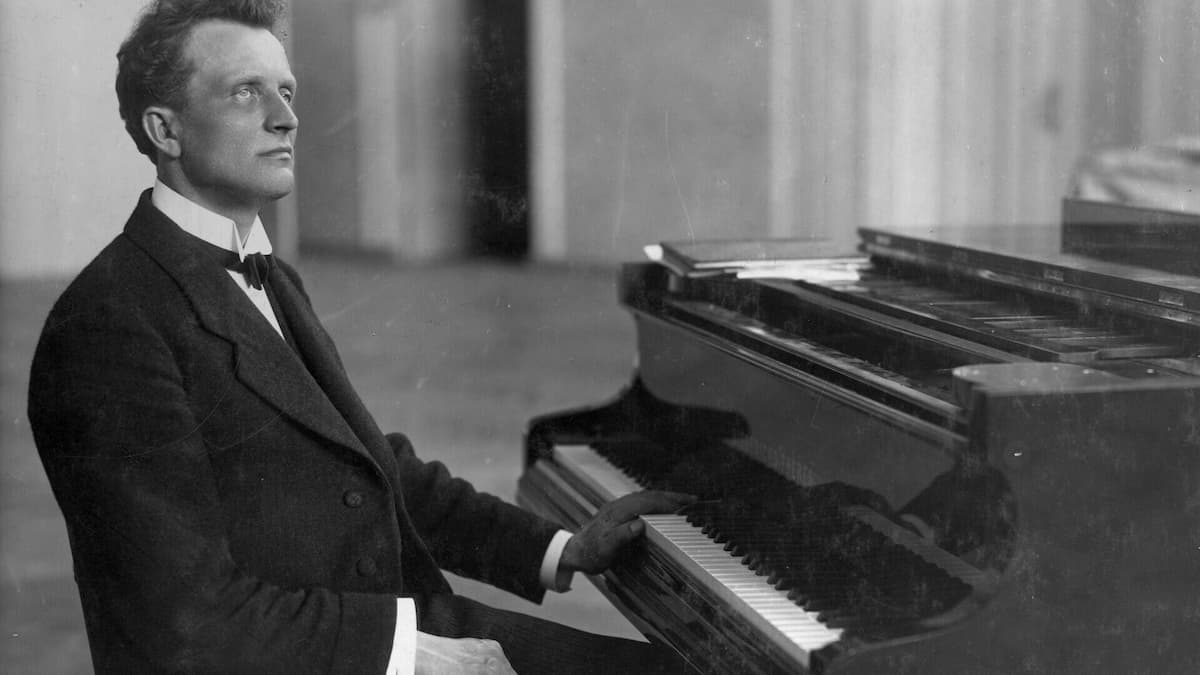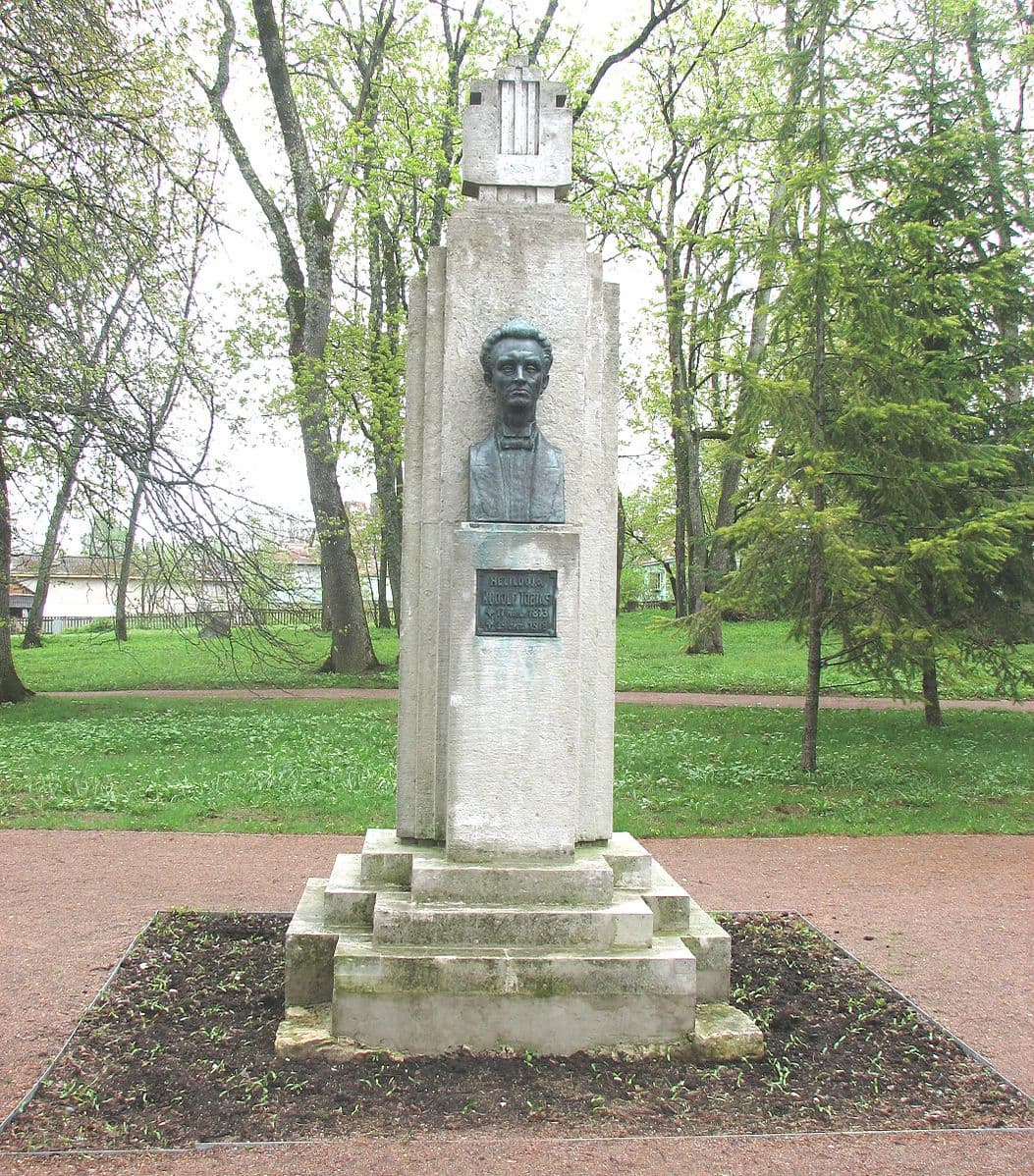When we hear music originating from the ancient shores of the Baltic Sea, we immediately think of the Estonian composers Veljo Tormis and Arvo Pärt. Of course, they are very famous right now, but their successes built on the ground-breaking and trailblazing music of Rudolf Tobias (1873-1918).

Portrait of Rudolf Tobias
I had actually never heard of Tobias, who is considered the first Estonian composer with a professional education and the man who laid the foundations of Estonian instrumental music. In fact, Tobias is responsible for a number of firsts, and since we are celebrating his birthday on 29 May, according to the new calendar, we thought it might be fun to listen to some of his trailblazing music.
First Estonian Symphonic Work
Rudolf Tobias: Julius Caesar “Overture” (Royal Scottish National Orchestra; Neeme Järvi, cond.)
Tobias was born in Käina, on the island of Hiiumaa, into a highly musical family. His father was a parish clerk and he was also the boy’s first teacher. Tobias was seriously talented and started composing at the age of nine. Like many of his compatriots, he was sent to the St Petersburg Conservatory and took organ lessons with Louis Homilius, and studied composition with Nikolai Rimsky-Korsakov.
His first large-scale work, and the first Estonian symphonic work ever written, was his overture to Julius Caesar. This work dates from 1896, and his time at the Conservatory. It is not difficult to hear that this music is primarily guided by his role models, Bach and Beethoven. Beethoven and the classical-romantic tradition certainly looms large in the Julius Caesar overture.
First Estonian Piano Concerto
Rudolf Tobias: Piano Concerto in D minor, (Concertstück)
Tobias graduated from the St Petersburg Conservatory in 1897, and his graduation work was the cantata Johannes Damascenus to a text by Alexei Tolstoy. This composition was another Estonian first, namely the first vocal-symphonic work in the history of Estonian music. Tobias was a deeply religious person, and we will later hear some sacred choral pieces that make up a significant part of his repertoire.
Additional pioneering works quickly followed as Tobias composed his Piano Concerto in D minor in 1897 as well. I probably don’t even have to tell you that this represents the first Estonian piano concerto. It all gets started with a broad introduction and the piano taking the lead. Smoothly unfolding melodies are punctuated by the orchestra, and the “Adagio” section presents a soulful melody. The rousing “Finale” sounds a number of delightful melodies interrupted by forceful punctuations.
First Estonian String Quartet

The young Rudolf Tobias
Rudolf Tobias: String Quartet No. 1 in D minor (Tallinn Quartet)
Almost as expected, Tobias also composed the first Estonian string quartet. It was written in 1899 in St Petersburg for a chamber music contest organised by the Russian impresario and patron Mitrofan Belyayev. Unfortunately, the work did not win any award, but the final movement titled “Nocturne” did not fail to make an impression.
The opening movement is written in traditional sonata form, and an epic first theme is followed by a lyrical and much more reversed musical contrast. A short development is based on active punctuated rhythms, and musical gestures recalled in the coda. The “Andante” is of great emotional warmth and is subtitled “Et in Arcadia ego,” while the “Scherzo’ presents a dance-like theme. And just listen to the very lively finale “Allegro.” It is not a complicated work, but remarkable for its craftmanship and vitality.
First Estonian Oratorio

Rudolf Tobias at the piano
Rudolf Tobias: Jonah’s Mission “Prolog” (Pille Lill, soprano; Urve Tauts, mezzo-soprano; Peter Svensson, tenor; Mati Palm, bass; Ines Maidre, organ; Oratorio Choir; Tallinn Boys Choir; Estonian Philharmonic Chamber Choir; Estonian State Symphony Orchestra; Neeme Järvi, cond.)
Tobias got his first job as a choirmaster and organist at St John’s, the Estonian church in St Petersburg. He stayed for six years but decided to move to the intellectual capital of Estonia, Tartu. There he worked as a music teacher and tutor, organised concerts, performed as both organist and pianist, and also was busy as a musical journalist. While in Tartu, he started to work on the oratorio Jonah’s Mission once again the first such composition in Estonia. His thoughts on contemporary church and sacred music were published in Germany in 1910.
“Mysterious strings invisibly connect aural art and the religious world and run between the superhuman and the mystical. All other art forms usually lack this transcendental ability, perhaps with the exclusion of poetry, however: how many verses, how many gusts of emotion are wasted by Dante when explaining the colourful facets of the history of the world. Modern musical artists lack the ability to be interested in everything transcendental, however, mostly they are unable to find material for the traditional forms of church music of the era.”
Jonah’s Mission
Rudolf Tobias: Jonah’s Mission “Jonah’s Mission” (Pille Lill, soprano; Urve Tauts, mezzo-soprano; Peter Svensson, tenor; Mati Palm, bass; Ines Maidre, organ; Oratorio Choir; Tallinn Boys Choir; Estonian Philharmonic Chamber Choir; Estonian State Symphony Orchestra; Neeme Järvi, cond.)
For many scholars and critics, Jonah’s Mission “is one of the most magnificent and monumental compositions an Estonian composer has ever written.” Tobias offers great artistic value and technical craftsmanship. However, more important is the philosophical conception of the works, as he wanted “to draw greater attention to the inner nature of our ear.” The composer was searching for individual self-expression in the contemporary oratorio genre.
Philosophy

Rudolf Tobias House Museum
Rudolf Tobias: Jonah’s Mission “The Night of Being Forsaken by God” (Pille Lill, soprano; Urve Tauts, mezzo-soprano; Peter Svensson, tenor; Mati Palm, bass; Ines Maidre, organ; Oratorio Choir; Tallinn Boys Choir; Estonian Philharmonic Chamber Choir; Estonian State Symphony Orchestra; Neeme Järvi, cond.)
To be sure, it is a deeply philosophical work expressing the composer’s vision of his people’s suffering, and of judgement and redemption. To some listeners, it has “Bach-like depth and solemnity, Handel-like grandiosity, and monumentality, and it approaches Bach and Handel in its masterly.” Tobias writes, “I hope that my work will not be lost for the Estonian people.”
“From the deepest roots of my heart have I raised it, while I was allowed to experience everything I wanted to tell about my hero,” he writes. Tobias was the first Estonian composer whose work actually reached Europe, and he attracted the attention of the press. A newspaper writes, “If he struck his lucky star, he could become the most important spiritual Estonian composer who would win respect outside the boundaries of his own country.”
Premiere
Rudolf Tobias: Jonah’s Mission “Ecclesia” (Pille Lill, soprano; Urve Tauts, mezzo-soprano; Peter Svensson, tenor; Mati Palm, bass; Ines Maidre, organ; Oratorio Choir; Tallinn Boys Choir; Estonian Philharmonic Chamber Choir; Estonian State Symphony Orchestra; Neeme Järvi, cond.)
Tobias had very little opportunity to perform such a grand work in Estonia, and he left for Western Europe in January 1908, traveling first to Paris and then to Germany. The final score of “Jonah” was completed in 1909, and the work premiered on 26 November in St. Andre’s Church in Leipzig.
The composer did conduct individual numbers of the work at various concerts in both Germany and Estonia, but the oratorio as a whole would not be performed again during Tobias’ life. It was successfully revived in Estonia and other European countries when it was restored by Estonian pianist and musicologist Vardo Rumessen in 1989.
Synthesis of Opera and Spirituality

Monument of Rudolf Tobias
Rudolf Tobias: Jonah’s Mission “Judgement” (Pille Lill, soprano; Urve Tauts, mezzo-soprano; Peter Svensson, tenor; Mati Palm, bass; Ines Maidre, organ; Oratorio Choir; Tallinn Boys Choir; Estonian Philharmonic Chamber Choir; Estonian State Symphony Orchestra; Neeme Järvi, cond.)
Jonah’s Mission is a work of Mahlerian proportions as it features a large orchestra, two mixed choruses, a chamber choir, a boys choir, five vocal soloists, organ and off-stage brass. It is almost two hours in length and based on the “Book of Jonah,” about the prophet who disobeys the Lord’s command and tries to flee.
Tobias borrows from two Germanic traditions. First, he uses leitmotifs and symphonic development as in Wagnerian operas, and also the contrapuntal choral tradition of Bach and Handel. The result is a large-scale synthesis of operatic drama and mystical spirituality.
Legacy
Rudolf Tobias: Jonah’s Mission “The Sign of the Son of Man” (Pille Lill, soprano; Urve Tauts, mezzo-soprano; Peter Svensson, tenor; Mati Palm, bass; Ines Maidre, organ; Oratorio Choir; Tallinn Boys Choir; Estonian Philharmonic Chamber Choir; Estonian State Symphony Orchestra; Neeme Järvi, cond.)
Tobias moved to Berlin in 1910 and was active as an organist and musical journalist. He also taught theory at the Hochschule der Music. In order to achieve full professorship, he took on German nationality in 1914, only to be called up for military service at the outbreak of World War I. He did work as an interpreter, but he was discharged on medical grounds in 1916.
Sadly, his health did not improve and he died from pneumonia on 29 October 1918, at the age of 45. Tobias left a good many works unfinished, including the oratorio Jenseits von Jordan, the cantata Ecclesia, and a third string quartet. Much of his music is still in manuscript, unperformed and unrecorded. Only very recently have scholars and performers re-discovered the music of this Estonian trailblazer. What other musical firsts are still to be found?
For more of the best in classical music, sign up for our E-Newsletter

